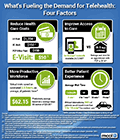
Members & Employers
8 Key Questions to Consider When Adding Telemedicine to Your Benefit Plan
Share this article
Telemedicine is changing the landscape of traditional health care. Is adding telemedicine to your benefit plan a good fit for your employees?
Here are eight key questions to keep in mind when adding telemedicine to your benefit plan:
-
- Will my employees be receptive to a telemedicine option? Change is difficult for anyone. Would your employees appreciate a convenient
option for short medical office visits without taking time away from work? Are after-hours urgent care and emergency room visits for minor ailments on the rise? Telemedicine could be the answer for you. Teladoc. External Link. Opens in new window., a leading telemedicine vendor reports an average savings of $673 on a telemedicine visit for a minor ailment instead of an in-person visit. - What types of telemedicine will be offered? And will there be worksite access to telemedicine available? Telemedicine communication
options differ by vendor. Will your workforce access telemedicine by telephone, email, smartphone app, or worksite patient kiosk video chat? More than one option may be available. Choose the option(s) that best fit the daily lives of your employees and their families. Consumers should also ask their current health care provider if telemedicine options are available. - Will adding telemedicine lower our total health care costs? Do your homework and analyze your health care claims data for trends. Short office visits and after-hours care for minor ailments are
good places to start. The ROI from a telemedicine visit can be startling. Telemedicine is perfect for after-hours care of minor ailments and routine short office visits. Weigh the cost of a 3 a.m. emergency room visit for the flu against the significantly smaller amount of time and money spent on a telemedicine visit. - What are the main health concerns of your employees that would be best addressed by
telemedicine? Did you see a spike in colds and flu diagnoses last winter? Allergy symptoms flaring up in the spring or fall? Frequent employee requests to leave work for a short medical consultation to discuss a child’s medical test results? A quick telemedicine visit may determine whether a longer, in-person office visit is needed – or not. Decreased wait-time to see a doctor, reduced anxiety about symptoms and increased productivity are all additional benefits to treating minor ailments with telemedicine.
additional benefits to treating minor ailments with telemedicine. - How will telemedicine be integrated into our current health benefits? Do your research when selecting your telemedicine vendor. Will a report on the visit be sent to the patient? Or to their primary doctor? The most effective programs will make the transition between telemedicine and in-person office visits as seamless as possible
- Who will be on my workplace team to ensure that telehealth is properly implemented? Human Resource staff may be your first team recruits. But also consider thought leaders in other
departments within your organization. Leverage the knowledge of your internal Wellness Team. They will help you generate ideas to effectively communicate your telehealth options to your entire workforce. - How will you construct a year-round telemedicine communications plan for your employees? Explain how and when telemedicine will be available to employees and their families. Use examples and tell stories to show when telemedicine is a great option for medical advice.

Make sure everyone is informed before they need to see a doctor. Create a communications calendar and schedule year-round employee communications to keep telemedicine at the top of their minds. And include communications sent to homes. Family members need telemedicine options, too, and women tend to make most health care decisions for the family. For maximum impact, create targeted communications to arrive at the start of allergy or flu season. - What kinds of data will be available to provide measurement of ROI? Make plans to measure the value of your telemedicine offerings. Analyze monthly utilization statistics, wait time to see a doctor, number of referrals to urgent care/emergency room visits and user satisfaction surveys. Statistics such as these will put you on the path to calculating your ROI.
- Will my employees be receptive to a telemedicine option? Change is difficult for anyone. Would your employees appreciate a convenient
Telemedicine is a great way to provide timely, quality health care and reduce unnecessary urgent care and emergency room visits. Strategically planning the launch and maintenance of your telemedicine benefits will increase their use by your workforce and their families.
[box]
Learn More About Adding Telemedicine to Your Benefit Plan:
- Telemedicine Moves into the Mainstream
- Millenials, aka ‘Digital natives,’ are changing health care
- Ten Things to Know About Telemedicine
- Alliance Learning Circle resources: The Changing Health Care Consumer: Telemedicine, millennials and the evolution of health care access
[/box]







